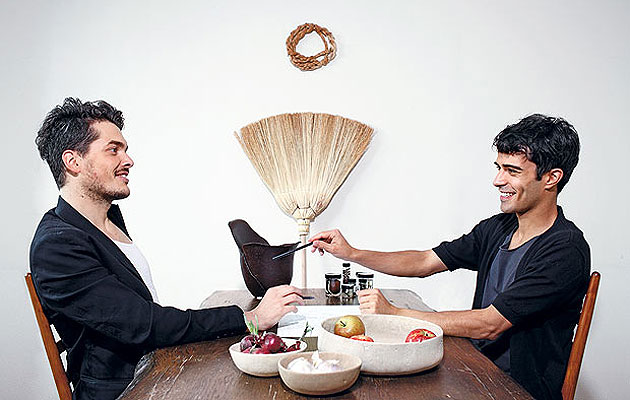|
|
||
|
Italian designer Simone Farresin is wearing an apron and standing over a frying pan containing thick amber-like resin when we first meet. He is preparing one of the mysterious base materials for Botanica, a range of exquisite and bizarre-looking vases that Andrea Trimarchi (the other half of Studio FormaFantasma) explains is an experimental design project using natural biodegradable plastics. The commission came from Plart, a Naples-based foundation concerned with plastic art preservation, which funds research into ways of making the material more sustainable. Looking to the past for inspiration, Studio FormaFantasma began investigating animal and plant polymers discovered by scientists in the 18th and 19th centuries. “We searched back in time to what we call the pre-Bakelite period, a time before plastic became completely synthetic,” Farresin says. A weird and wonderful catalogue of rediscovered plastics emerged from the research, including: bois durci, a 19th-century material composed of sawdust and animal blood; copal, a sub-fossil state of amber; shellac, a polymer extracted from insect excrement; and dammar, a resin from a tropical tree. Some are still used for furniture restoration and were readily available on the market, while others were fabricated by Farresin and Trimarchi in the studio. To make the vases, flakes of resin are melted and then rolled into a thin layer. A heat gun is used to make them malleable enough to be coaxed into their plaster moulds. “It’s a nice way of working,” Farresin says. “When you want to rework a part you can heat it up and cut it with scissors. It’s really quite intuitive.” The collection, originally presented at Spazio Rossana Orlandi during April’s Milan Furniture Fair, started as individual preconceived designs but evolved as Studio FormaFantasma became more familiar with the nature of its newfound materials. “Like, for instance, these things,” Farresin says, pointing to one vase’s petal-like layers of excess resin where the material had been pushed into the mould. “They come from the way we make the pieces,” Trimarchi adds. “The design really follows the language of the material. At the beginning we were trapping the shape but then it began speaking for itself. So we let it speak.”
credit Luisa Zanzani The rustic aesthetic of the Botanica materials and their earthy organic tones has been refined with various fashion-inspired embellishments. One has a feather headband, while another wears a cape of textured scales, neatly threaded together with a tailor’s precision. Like prehistoric clothing or artefacts but distinctly contemporary, they entreat us to reconsider the established view of plastic as a cheap, colourful, synthetic and commonplace material. “What would have happened if oil was never discovered?” Trimarchi asks. “Would plastic have been precious and decorative … the basis of craft rather than mass production?” The intersection of craft and design recurs as a territory explored in several of the studio’s projects – sensitive studies that reconcile the skill and tradition of folk crafts with modern design sensibilities. Domestica, a Dilmos Gallery commission, reinterpreted the Gerla basket, (a cocoon-like cereal harvesting basket traditionally worn on labourers’ backs in northern Italy) by combining it with a low stool for resting. In Basel the pair presented Colony for Gallery Libby Sellers: a textile series that expands on issues raised by Moulding Tradition, the MA project they completed at Design Academy Eindhoven in 2009. Neutral-coloured mohair blankets are decorated with intricate patterns that trace the paths of migrants between Italy and its African colonies over history. Layers of dates, maps and information are brought together as a new way of thinking critically about geopolitics, migration and cultural assimilation. Studio FormaFantasma sees weaving historical messages into its products as a way to respect and reinterpret craft rather than leave it marginalised by mainstream contemporary design. “We need to make sure that we’re not discarding techniques that could still have use and meaning,” says Farresin. “We have a duty to keep revisiting established aesthetics to see if they have other potentials.”
credit Luisa Zanzani
credit Luisa Zanzani |
Image Raoul Kramer
Words Riya Patel |
|
|
||






















